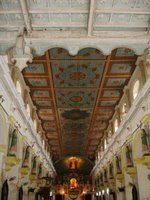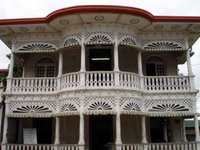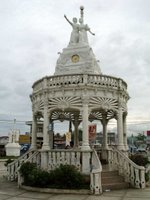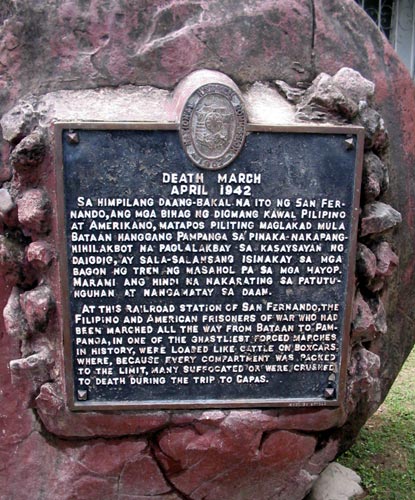 They call it a piece of Hawaii in the Philippines. But indeed, the Mount Malarayat Golf and Country Club in Lipa, Batangas offers some of the best views of Philippine landscape architecture at its finest. I was lucky to spend a relaxing day enjoying the serene views of a well-landscaped golf course amidst the backdrop of Mount Malarayat. Such a conducive place for a meeting that would otherwise have been quite exhausting if not for the great view from the function room.It turns out, the landscape architects were led by none other than National Artist for Architecture, Ildefonso P. Santos and Associates as well as Pesons, Dimanlig, Aleta, Alcazaren (PDAA) Partners whom I believe are professors of landscape architecture at the University of the Philippines.I hope we get more of the Philippines landscaped by professionals!
They call it a piece of Hawaii in the Philippines. But indeed, the Mount Malarayat Golf and Country Club in Lipa, Batangas offers some of the best views of Philippine landscape architecture at its finest. I was lucky to spend a relaxing day enjoying the serene views of a well-landscaped golf course amidst the backdrop of Mount Malarayat. Such a conducive place for a meeting that would otherwise have been quite exhausting if not for the great view from the function room.It turns out, the landscape architects were led by none other than National Artist for Architecture, Ildefonso P. Santos and Associates as well as Pesons, Dimanlig, Aleta, Alcazaren (PDAA) Partners whom I believe are professors of landscape architecture at the University of the Philippines.I hope we get more of the Philippines landscaped by professionals!
I really wonder how long it will take the board of the National Historical Institute to declare more heritage towns. At the moment, only five are in the NHI list namely Silay in Negros Occidental, Taal in Batangas, Pila in Laguna, Dapitan in Zamboanga del Norte and Malolos in Bulacan. Vigan of course is already a UNESCO World Heritage Site. But many candidates have been screaming for declarations such as San Miguel de Mayumu in Bulacan, Sariaya in Quezon Province, San Juan in Batangas and Carcar in Cebu Province. As I promised last March, I would talk more about the heritage town of Carcar. I was looking through some old articles on Carcar and it turns out, there was already a bill proposed in Congress. I wonder why it had to be done when it needed a simple board resolution from the NHI. Anyway, the article from the Manila Bulletin dated May 1, 2005 states, "Cebu Rep. Eduardo Gullas has filed a bill seeking to declare the municipality of Carcar, home to numerous historical structures and artifacts, a national cultural heritage zone.
As I promised last March, I would talk more about the heritage town of Carcar. I was looking through some old articles on Carcar and it turns out, there was already a bill proposed in Congress. I wonder why it had to be done when it needed a simple board resolution from the NHI. Anyway, the article from the Manila Bulletin dated May 1, 2005 states, "Cebu Rep. Eduardo Gullas has filed a bill seeking to declare the municipality of Carcar, home to numerous historical structures and artifacts, a national cultural heritage zone. "Located about 40 kilometers southwest of Cebu City, Carcar is just like Vigan City in Ilocos Sur, boasting of various architecturally significant vintage houses built during the Spanish era and a classical church, Gullas said."A cultural heritage zone refers to historical, anthropological, archaeological and artistic geographical areas and settings that are actually culturally important to the country."It has become absolutely necessary for us to preserve and protect Carcar's historical structures in the interest of enriching the national patrimony," Gullas said.
"Located about 40 kilometers southwest of Cebu City, Carcar is just like Vigan City in Ilocos Sur, boasting of various architecturally significant vintage houses built during the Spanish era and a classical church, Gullas said."A cultural heritage zone refers to historical, anthropological, archaeological and artistic geographical areas and settings that are actually culturally important to the country."It has become absolutely necessary for us to preserve and protect Carcar's historical structures in the interest of enriching the national patrimony," Gullas said. "Century-old buildings that still stand up to now remind the youth of the grandeur and aesthetic splendor of the architectural design of the past," Gullas added.The article adds, "Under House Bill 3762, Carcar, once declared a cultural heritage zone, shall be subject to the rules and regulations governing the preservation of such sites."I salute Congressman Gullas for this effort. Maybe the congressmen of the other towns I've mentioned should file similar bills since it seems it will take the NHI forever to make the badly-needed declarations.
"Century-old buildings that still stand up to now remind the youth of the grandeur and aesthetic splendor of the architectural design of the past," Gullas added.The article adds, "Under House Bill 3762, Carcar, once declared a cultural heritage zone, shall be subject to the rules and regulations governing the preservation of such sites."I salute Congressman Gullas for this effort. Maybe the congressmen of the other towns I've mentioned should file similar bills since it seems it will take the NHI forever to make the badly-needed declarations. As Architect Toti Villalon stated in his column last December 2005, "A model for public-private cooperation is now in place with the recent provincial declaration of Carcar as a Heritage Town and the passing of the Carcar heritage bill which designates heritage zones, levels of protection for heritage structures, and, most importantly, enlists the participation of the Carcar Heritage Conservation Society to provide technical expertise in the task of preserving their historic town."
As Architect Toti Villalon stated in his column last December 2005, "A model for public-private cooperation is now in place with the recent provincial declaration of Carcar as a Heritage Town and the passing of the Carcar heritage bill which designates heritage zones, levels of protection for heritage structures, and, most importantly, enlists the participation of the Carcar Heritage Conservation Society to provide technical expertise in the task of preserving their historic town." In an earlier column, Toti describes the town, "Carcar's treasures go beyond the town's colonial homes, church and convento."Its calado architecture from the 1920s is unsurpassed in the country. The wooden faćades of the Carcar Dispensary and Saint Catherine's Academy have carved fretwork so delicate it seems like they could flutter with the breeze like fragile heirloom lace."Wooden houses from the unappreciated post-war era still stand in Carcar streets, a type of architecture so descriptive of life during that forgotten period of our national history which is sadly dismissed by many as not of heritage quality.
In an earlier column, Toti describes the town, "Carcar's treasures go beyond the town's colonial homes, church and convento."Its calado architecture from the 1920s is unsurpassed in the country. The wooden faćades of the Carcar Dispensary and Saint Catherine's Academy have carved fretwork so delicate it seems like they could flutter with the breeze like fragile heirloom lace."Wooden houses from the unappreciated post-war era still stand in Carcar streets, a type of architecture so descriptive of life during that forgotten period of our national history which is sadly dismissed by many as not of heritage quality. "A wonderful round kiosk from the American period, one of the best surviving examples of its genre in the country, valiantly stands at the center of the Carcar Rotunda, whose pride of place is now totally stolen by offending super large-scale billboards."Indeed, that kiosk is one of a kind. I remember it was at the heart of a controversy between the townsfolk and the DPWH who proposed that it be demolished to giveway to some road widening. Yikes! There go our government engineers again who churn up the ugliest infrastructure in the world! Good thing the opposition to the DPWH plan was loud and clear.Carcar is now protected not just by a provincial resolution but by a national law. But the question still is, didn't that need only a simple board resolution from the NHI?
"A wonderful round kiosk from the American period, one of the best surviving examples of its genre in the country, valiantly stands at the center of the Carcar Rotunda, whose pride of place is now totally stolen by offending super large-scale billboards."Indeed, that kiosk is one of a kind. I remember it was at the heart of a controversy between the townsfolk and the DPWH who proposed that it be demolished to giveway to some road widening. Yikes! There go our government engineers again who churn up the ugliest infrastructure in the world! Good thing the opposition to the DPWH plan was loud and clear.Carcar is now protected not just by a provincial resolution but by a national law. But the question still is, didn't that need only a simple board resolution from the NHI?
Related article
On another note, check out the article Church heritage and the Pardo controversy in the Cebu Daily News which is related to our petition to the CBCP. It shows you how many of our priests think. What's sick about the Pardo issue is the fact that Cardinal Vidal already came out with an order for all priests to seek approval of Cebu's Archdiocesan Commission for the Cultural Heritage of the Church for any church renovation but priests still disregard it.
 The past three days have been dedicated to meetings and surveying of the heritage sites of San Fernando. We are one in a rare breed of cities in the country which are agressively pursuing heritage conservation. On Wednesday, we met with representatives of the San Fernando, Pampanga Heritage Foundation, Filipino-American Memorial Endowment, American Chamber of Commerce, Battling Bastards of Bataan and the Defenders of Bataan and Corregidor regarding the plans of the city to restore the San Fernando Train Station and to open a Death March memorial and museum in the site.
The past three days have been dedicated to meetings and surveying of the heritage sites of San Fernando. We are one in a rare breed of cities in the country which are agressively pursuing heritage conservation. On Wednesday, we met with representatives of the San Fernando, Pampanga Heritage Foundation, Filipino-American Memorial Endowment, American Chamber of Commerce, Battling Bastards of Bataan and the Defenders of Bataan and Corregidor regarding the plans of the city to restore the San Fernando Train Station and to open a Death March memorial and museum in the site. For those who are not yet aware of the significance of the said train station, it was the ending point of the long 102-kilometer walk from Mariveles, Bataan in April 1942. At the station, thousands of Filipino and American POWs were stuffed like sardines into box carts and transported to Capas, Tarlac. Anyway, expect more updates but the biggest hurdle is the slow response of the Philippine National Railways Corporation which is the owner of the said property.Yesterday was my rest day. I spent my 27th at home sleeping. Hehe! I decided that the best way for me to celebrate was to give myself the rest I badly needed.
For those who are not yet aware of the significance of the said train station, it was the ending point of the long 102-kilometer walk from Mariveles, Bataan in April 1942. At the station, thousands of Filipino and American POWs were stuffed like sardines into box carts and transported to Capas, Tarlac. Anyway, expect more updates but the biggest hurdle is the slow response of the Philippine National Railways Corporation which is the owner of the said property.Yesterday was my rest day. I spent my 27th at home sleeping. Hehe! I decided that the best way for me to celebrate was to give myself the rest I badly needed.  Today, a survey team of the National Historical Institute arrived to inspect more houses for possible declaration. San Fernando is trying to increase its number of declared structures and glad to say, all the other house owners have already given their consent and are excited about the possible declaration. For one, the city will soon be granting real estate tax exemptions to all heritage house owners to encourage them to preserve their homes.
Today, a survey team of the National Historical Institute arrived to inspect more houses for possible declaration. San Fernando is trying to increase its number of declared structures and glad to say, all the other house owners have already given their consent and are excited about the possible declaration. For one, the city will soon be granting real estate tax exemptions to all heritage house owners to encourage them to preserve their homes. Among the strongest contenders is the Singian House which was built in the mid-19th century. It could in fact be the oldest surviving house in San Fernando. The house is very well-maintained by its current owners. If it was indeed built in the 1850s, I suspect its original owner was Don Bernardino Singian de Miranda, a former gobernadorcillo of San Fernando from whom many of San Fernando's prominent families trace their roots. Don Bernardino is the grandfather of eminent pre-war surgeon Dr. Gregorio Singian.Beside the house is a really large camalig which is very well-preserved also. Structures like these form part of the industrial heritage of the city and are a rarity nowadays.
Among the strongest contenders is the Singian House which was built in the mid-19th century. It could in fact be the oldest surviving house in San Fernando. The house is very well-maintained by its current owners. If it was indeed built in the 1850s, I suspect its original owner was Don Bernardino Singian de Miranda, a former gobernadorcillo of San Fernando from whom many of San Fernando's prominent families trace their roots. Don Bernardino is the grandfather of eminent pre-war surgeon Dr. Gregorio Singian.Beside the house is a really large camalig which is very well-preserved also. Structures like these form part of the industrial heritage of the city and are a rarity nowadays. Another strong contender is the charming Victorian-inspired Hizon House along Consunji Street. It was built by Don Teodoro Santos, Jr. and Dona Africa Ventura and later purchased by Maria Hizon who served as a nurse in the Philippine Revolutionary Army. It is currently owned by the heirs of her nephew, Don Augusto Hizon.There are more candidates in the list. But it's all up to the NHI Board which has the final say. This however may take longer than it used to since I heard the board rarely convenes for meetings. Sigh!I guess that's it for now. To learn more about the heritage sites in San Fernando, click here.
Another strong contender is the charming Victorian-inspired Hizon House along Consunji Street. It was built by Don Teodoro Santos, Jr. and Dona Africa Ventura and later purchased by Maria Hizon who served as a nurse in the Philippine Revolutionary Army. It is currently owned by the heirs of her nephew, Don Augusto Hizon.There are more candidates in the list. But it's all up to the NHI Board which has the final say. This however may take longer than it used to since I heard the board rarely convenes for meetings. Sigh!I guess that's it for now. To learn more about the heritage sites in San Fernando, click here.
 They call it a piece of Hawaii in the Philippines. But indeed, the Mount Malarayat Golf and Country Club in Lipa, Batangas offers some of the best views of Philippine landscape architecture at its finest. I was lucky to spend a relaxing day enjoying the serene views of a well-landscaped golf course amidst the backdrop of Mount Malarayat. Such a conducive place for a meeting that would otherwise have been quite exhausting if not for the great view from the function room.
They call it a piece of Hawaii in the Philippines. But indeed, the Mount Malarayat Golf and Country Club in Lipa, Batangas offers some of the best views of Philippine landscape architecture at its finest. I was lucky to spend a relaxing day enjoying the serene views of a well-landscaped golf course amidst the backdrop of Mount Malarayat. Such a conducive place for a meeting that would otherwise have been quite exhausting if not for the great view from the function room.










